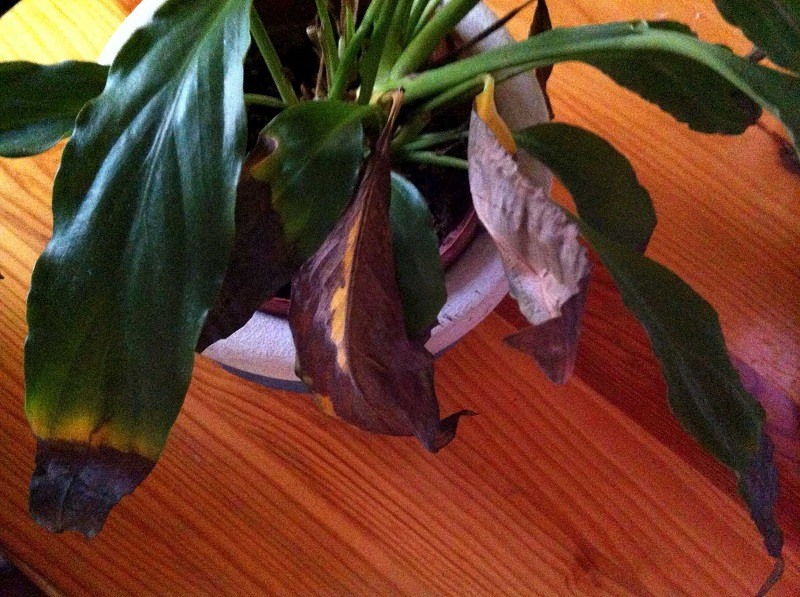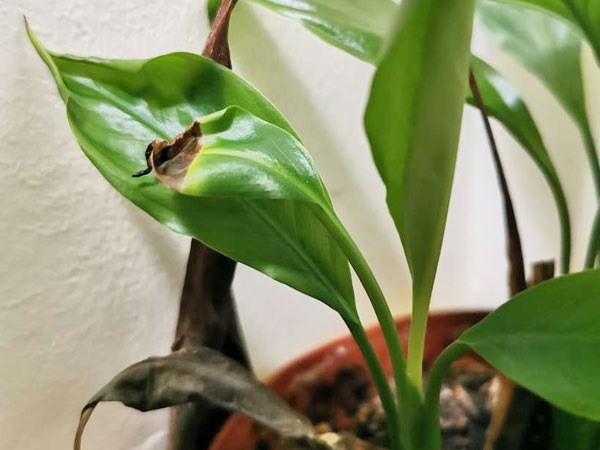We all love peace lilies since they are easy to grow and maintain. They are also among the best houseplants for purifying the air with their beautiful flowers. But you need to be aware of peace lilies’ indoor problems while growing.
So, why is my peace lily leaves turning brown? The leading causes are inappropriate watering, direct sunlight exposure, over-fertilization, low humidity, and extreme temperatures. Browning of the peace lily leaves can occur in different ways.
Identifying the exact cause behind the brown leaves will provide a clue towards finding the best solution. We wrote this article to help you pinpoint the exact causes and probable solutions to fixing them.

Reasons for Peace Lily Leaves Turning Brown
Peace lilies are tropical evergreen plants that can thrive both indoors and outdoors. But these rainforest plants are sensitive to changes in soil and air. Browning foliages are signs of adjustment to changes or improper care routine.
Determining the root cause of the problem to your peace lily is vital. The information will help prevent misdiagnosis and save your plant. Below are the possible causes of peace lily leaves turning brown.
Under-watering Problem
Inconsistent watering habit is the leading cause of brown leaves on peace lily. These tropical plants can tolerate a dry condition, but leaving them in drought for an extended period can weaken them.
Brown leaves occur since the means for the supply of nutrients is lacking. The plant will receive insufficient nutrients resulting in brown patches on the leaves. Under-watering will not only make your peace lily thirsty but also hungry.
We recommend testing the moisture content in the soil to confirm if it is dry. Soaking the potting soil will help rehydrate your peace lily and bring back the elegant green leaves on the track. Be sure to use rainwater or distilled water to rehydrate your houseplant.
Remember that peace lilies will require more water supplies during the spring and summer due to their active growth. Reduce the watering frequency during the fall and winter seasons due to the dormancy effect.
Overwatering Issue
Peace lilies thrive in moist soil that never gets soggy. Too much water will create a swampy environment that will ruin the peace lily’s survival chance. A damp potting soil hinders the roots from accessing the oxygen leading to their suffocation.
The soggy environment can also weaken and damage the roots by rotting them. Damage roots inhibit the supply of vital nutrients to the entire plant leading to browning leaves. Other signs of an overwatered peace lily are leaves yellowing, drooping, and curling.
We recommend investigating your houseplant and soil for any sign of fungal growth by smelling around the potting soil. The best solution is to re-potting the peace lily into a new container and fresh potting soil.
Water Quality Effect
Many peace lily enthusiasts focus only on the proper amount of water to foster elegant green foliages. Neglecting the quality could cause the plant leaves to turn brown since peace lilies are sensitive to minerals.
Tap water contains adverse chemicals (chlorine and fluorine) that will burn your peace lily foliages. Browning foliages occurs due to excessive buildup of these harmful substances around the plant.
Chlorine and fluorine usually block the stomata and leaf margins to prevent transpiration. The scenario later hinders photosynthesis and results in leaves turning brown. But there is no need to freak since the water quality effect is reversible.
Avoid using tap water to irrigate your peace lilies to prevent leaves from turning brown. We recommend letting the tap water sit overnight for the harmful minerals to coagulate and decant before watering the houseplants. (Source: Pacific Northwest Pest Management Handbook).
Distilled water and rainwater are the best alternatives to tap water. The water type lacks minerals that ruin or damage the beautiful lush peace lilies. Be sure to contact your local water authority to check its quality before using it on your houseplants.
Direct Sunlight Exposure
Peace lilies thrive under bright indirect sunlight to promote lush growth. Too much or little light could harm them. Artificial or natural light will help the plant experience photosynthesis to enhance healthy growth.
Exposing your peace lilies to direct sunlight for an extended period will scorch them. Prolonged exposure to direct sunlight will result in leaves turning brown, drooping, and curling. The condition will also weaken your peace lily and even kill it.
We recommend relocating the peace lily to a spot that receives bright indirect sunlight. Ensure the windows have sheer curtains to help reduce the sunlight intensity. Artificial lights are the best option for natural light while growing peace lilies indoors.
Be sure to trim the sunburn foliages to help divert nutrients to growing regions. Trimming also helps improve the plant’s general appearance after the sunburn effect.
Pest Infestations
Peace lilies are vulnerable to insect infestations, whether grown indoors or outdoors. These tiny creatures can attack and damage your houseplants. Examples of insects that attack peace lily foliages are spider mites, mealybugs, scales, and aphids.
These insects suck the cell sap and damage vital leaf tissues. The venom released into the leaves enhances fungal growth that inhibits photosynthesis. Peace lily leaves turning brown are signs of severe insect infestations.
Rinse your peace lily plant with mild soap and water to combat pest infestation. Wipe the affected foliages with a cotton swab dipped in an alcoholic solution to eliminate the pests. Be sure to isolate the houseplant from others to prevent spreading.
Low Humidity
Peace lilies are native to the tropical rainforest of Central America and Southeast Asia. These regions receive average humidity that fosters healthy growth among peace lilies. Low humidity is responsible for wilting and leaves turning brown.
The peace lily brown leaves occur due to fast transpiration rate than water uptake. The rapid water loss dehydrates the plant leading to leaves curling and browning. We recommend increasing the indoor humidity level to prevent leaves from turning brown.
Install an electric humidifier to boost indoor humidity, which is beneficial to plants and humans. Be sure to promote adequate air circulation to prevent insect infestation and mold growth around the plant.
Extreme Temperatures
Peace lilies prefer a temperature range of 65-75oF (18-24oC) during the day and up to 10oF (-20oC) cooler during the night. (Source: University of Vermont).
The high temperature will increase the transpiration and respiration rate among the indoor peace lilies. The plants will lose water at a faster rate than the uptake leading to leaves browning.
On the other hand, low temperature will result in frost injury among your peace lilies. The ice crystals around the plant will damage vital tissues that inhibit photosynthesis.
Both low and high temperatures have a harmful effect on houseplants. We recommend keeping the peace lilies away from heat vents and cold drafts to prevent leaves from turning yellow.
Plant Diseases
Peace lilies are less vulnerable to plant diseases. But this does not make them invincible to common leaf problems like browning or yellowing.
If you notice your peace lily foliages are turning brown, it could be due to petiole and bacterial leaf rot diseases. (Source: The Pharma Innovation Journal).
We recommend cutting the affected foliages to prevent spreading to other houseplants. Apply fungicide to the light-affected plants and discard the ones severely counterparts.

Conclusion
I hope the factors mentioned in this article will help you figure out the causes of peace lily leaves turning brown. Take the time to read through the information and investigate your houseplant to identify the exact cause before fixing it. Feel free to share your experiences or insights in the comment section below.
Readers Who Read This Also Read:
